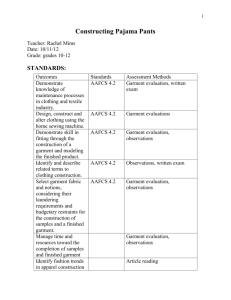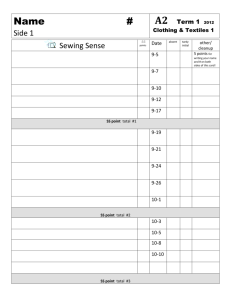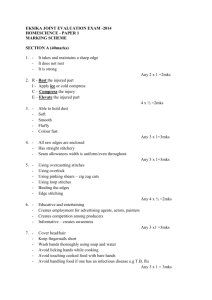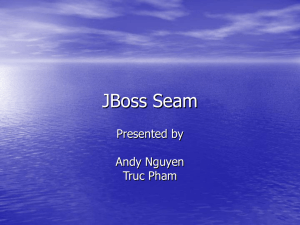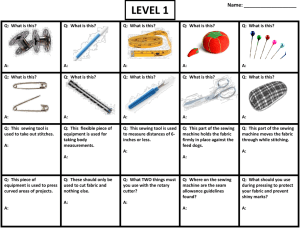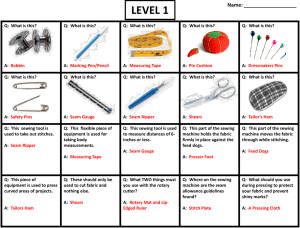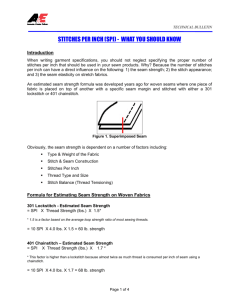Apparel I Sewing Techniques Project and Rubric
advertisement
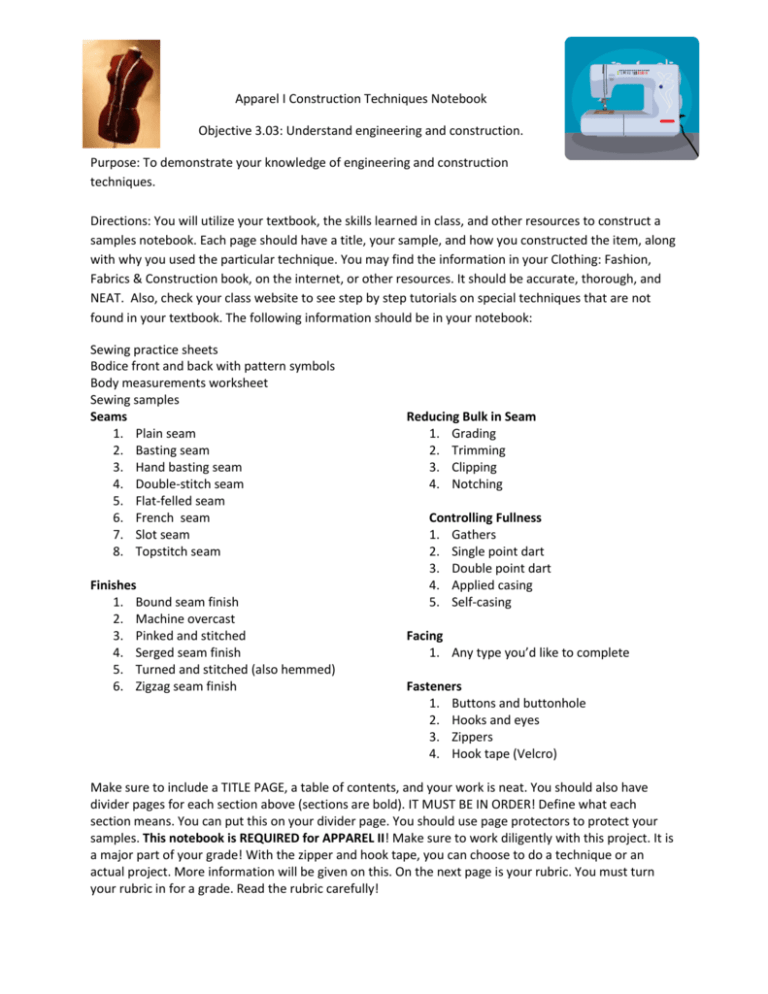
Apparel I Construction Techniques Notebook Objective 3.03: Understand engineering and construction. Purpose: To demonstrate your knowledge of engineering and construction techniques. Directions: You will utilize your textbook, the skills learned in class, and other resources to construct a samples notebook. Each page should have a title, your sample, and how you constructed the item, along with why you used the particular technique. You may find the information in your Clothing: Fashion, Fabrics & Construction book, on the internet, or other resources. It should be accurate, thorough, and NEAT. Also, check your class website to see step by step tutorials on special techniques that are not found in your textbook. The following information should be in your notebook: Sewing practice sheets Bodice front and back with pattern symbols Body measurements worksheet Sewing samples Seams 1. Plain seam 2. Basting seam 3. Hand basting seam 4. Double-stitch seam 5. Flat-felled seam 6. French seam 7. Slot seam 8. Topstitch seam Finishes 1. Bound seam finish 2. Machine overcast 3. Pinked and stitched 4. Serged seam finish 5. Turned and stitched (also hemmed) 6. Zigzag seam finish Reducing Bulk in Seam 1. Grading 2. Trimming 3. Clipping 4. Notching Controlling Fullness 1. Gathers 2. Single point dart 3. Double point dart 4. Applied casing 5. Self-casing Facing 1. Any type you’d like to complete Fasteners 1. Buttons and buttonhole 2. Hooks and eyes 3. Zippers 4. Hook tape (Velcro) Make sure to include a TITLE PAGE, a table of contents, and your work is neat. You should also have divider pages for each section above (sections are bold). IT MUST BE IN ORDER! Define what each section means. You can put this on your divider page. You should use page protectors to protect your samples. This notebook is REQUIRED for APPAREL II! Make sure to work diligently with this project. It is a major part of your grade! With the zipper and hook tape, you can choose to do a technique or an actual project. More information will be given on this. On the next page is your rubric. You must turn your rubric in for a grade. Read the rubric carefully! Sewing Techniques Notebook Rubric Grading Criteria Problem Solving 6 Points (Mastery) - Uses guiding question to assist with reading instructions - Helps others and works cooperatively to seek out help with project Reading directions -Successfully and correctly interprets sewing instructions to complete each step. - Read directions before seeking help from instructor. Seams (48 total points possible) -Stitches are even, backstitched, and correct length to side of fabric. - Sample page is properly labeled, sample is properly attached, and information is adequately there. -There are no loose threads and hand sewing is neat. -Stitches are even, backstitched, and correct length to fabric. - Pages are properly labeled, no spelling mistakes, and has adequate information. -There are no loose threads. -Stitches are even, backstitched, and trimmed - Correct method of reducing bulk for each Seam Finishes (36 total points possible) Reducing Bulk (24 points possible) 4 Points (Satisfactory) - Attempts to use guided questions but avoids using them. - Seeks out instructor help more than from other students or guiding questions - Attempts to interpret directions but does not apply to project. - Reads instructions but frequently does not start with them before seeking help. - Stitches occasionally become uneven or unstraight. - Most lines are backstitched. - Hand sewing is tight, but too big or uneven. - Samples are not pressed. 2 Points (Unsatisfactory) - Does not use guiding questions unless prompted to do so. - Does not work cooperatively with other students to gain support. 0 points (Incomplete) - Waits for teacher to read directions. - Disrupts cooperative work and doesn’t show evidence of working independently. - Rarely uses directions with project. - Seeks help from teacher only- does not take the time to read independently. - Does not read directions or attempt to work independently. - Waits for instructor to move on with project. - Few stitches are straight. -Forgets to backstitch or secure ends. - Hand sewing is done incorrectly and is messy. - All stitches are not straight. - Never secures stitch with backstitching. Hand sewing does not hold together project. -Some samples are missing or just sloppy - Stitches occasionally become uneven or unstraight. -Most lines are backstitched. - Few spelling mistakes. -Samples are not pressed. -Stitches occasionally become uneven or unstraight. -Most lines are -Few stitches are straight. -Forgets to backstitch or secure ends. -Information is lacking or inaccurate. -All stitches are not straight. -Never secures stitch with backstitching. -Samples are missing or just sloppy. Information is completely inaccurate. - Few stitches are straight. -Forgets to backstitch or secure ends. - Information is -All stitches are not straight. -Never secures stitch with backstitching. -Samples are missing Total Points Sewing Techniques Notebook Rubric seam identified -Pages are properly labeled, no spelling mistakes, and adequate information. -There are no loose threads. Controlling Fullness Facing Stitches are even, backstitched, and trimmed -Correct method of controlling fullness -Labeling is correct and no spelling errors -Stitches are even, backstitched, and correct length to side of fabric. - Sample page is properly labeled, sample is properly attached, and information is adequately there. -There are no loose threads and hand sewing is neat. Participation -Worked quietly and and work consistently on ethic project. -Put materials away and left work area clean. Uses materials and sewing machine safely. Total Points backstitched. -Few spelling mistakes. -Samples are not pressed. -The methods of reducing bulk can be seen, but not correctly. -Stitches are occasionally uneven. -Darts have small dimples, but hardly noticeable. -Few spelling mistakes. Samples are not pressed properly. lacking or inaccurate. or just sloppy. -No evidence of attempting to reduce bulk or what that means. -Few stitches are straight. -Forgets to secure ends or backstitch. -Darts are hardly pressed and did not tie knots at end. -Casing does not lie flat. -Information is lacking or inaccurate. -All stitches are not straight. -Never secures stitch with backstitching. -Samples are missing or just sloppy. -No evidence of controlling fullness techniques. - Stitches occasionally become uneven or unstraight. - Most lines are backstitched. - Hand sewing is tight, but too big or uneven. - Samples are not pressed. -Few stitches are straight. -Forgets to backstitch or secure ends. -Information is lacking or inaccurate. -All stitches are not straight. -Never secures stitch with backstitching. -Samples are missing or just sloppy. Information is completely inaccurate. -On most days worked consistently and left work area clean. -some productivity issues. -Occasional unsafe practices. -Frequently left area messy, did not work effectively throughout the period on most days. -Unsafe practices were frequently noted. -Always left area messy, little to no work accomplished during most days. -Poor use of work time. -Unsafe in all areas.
